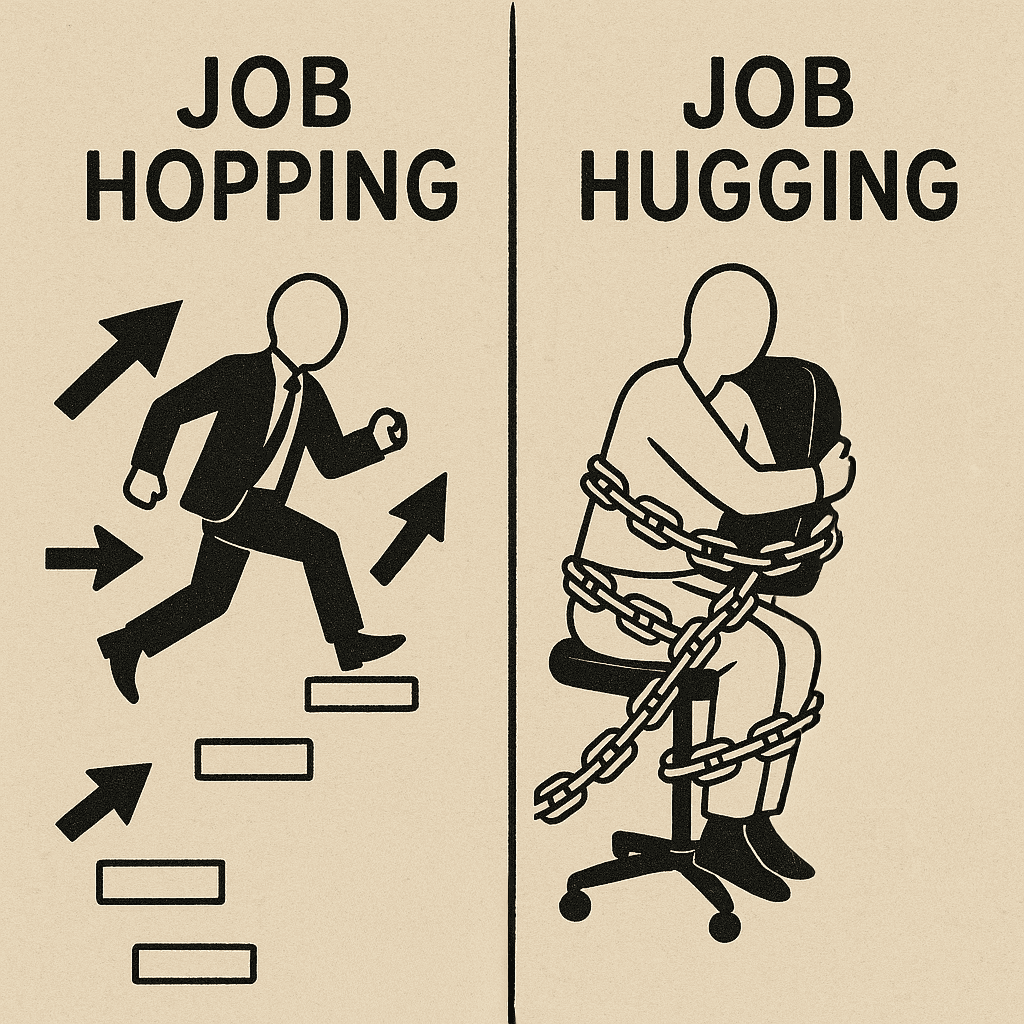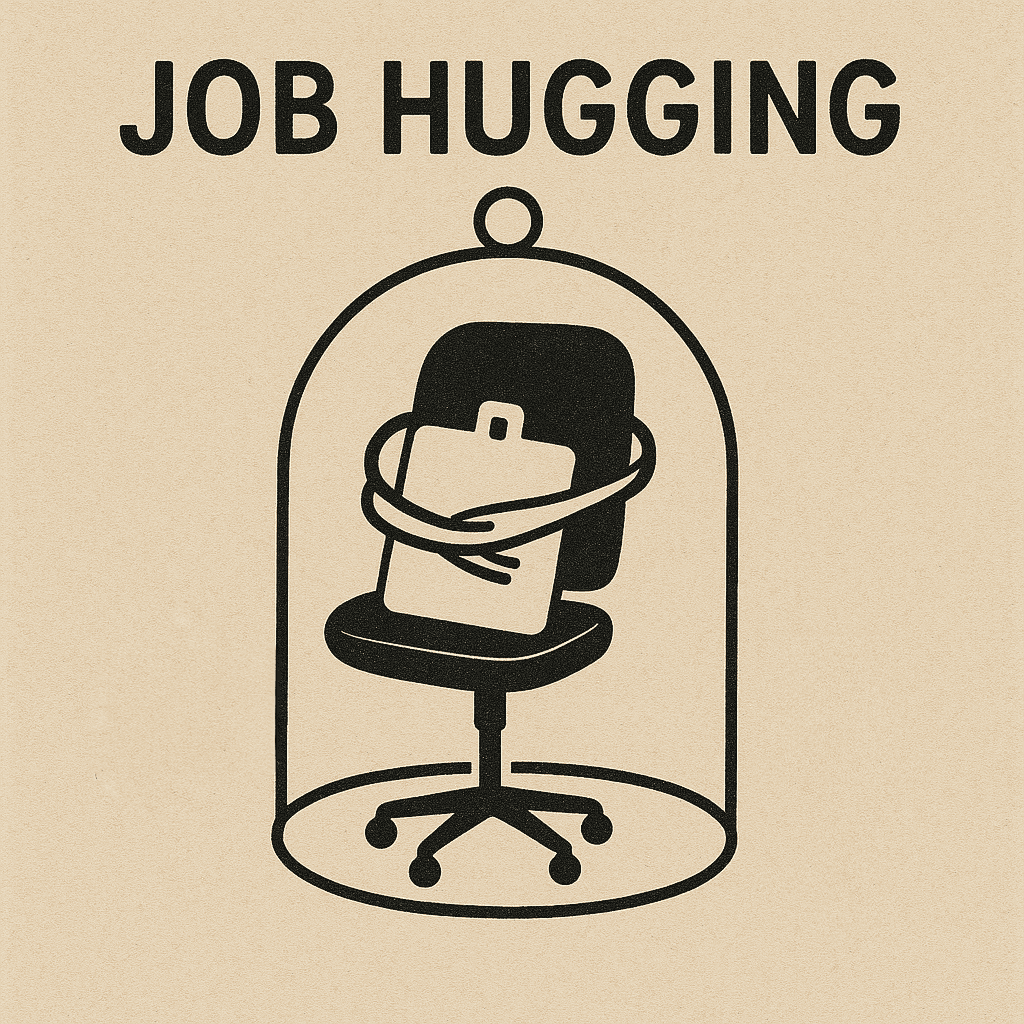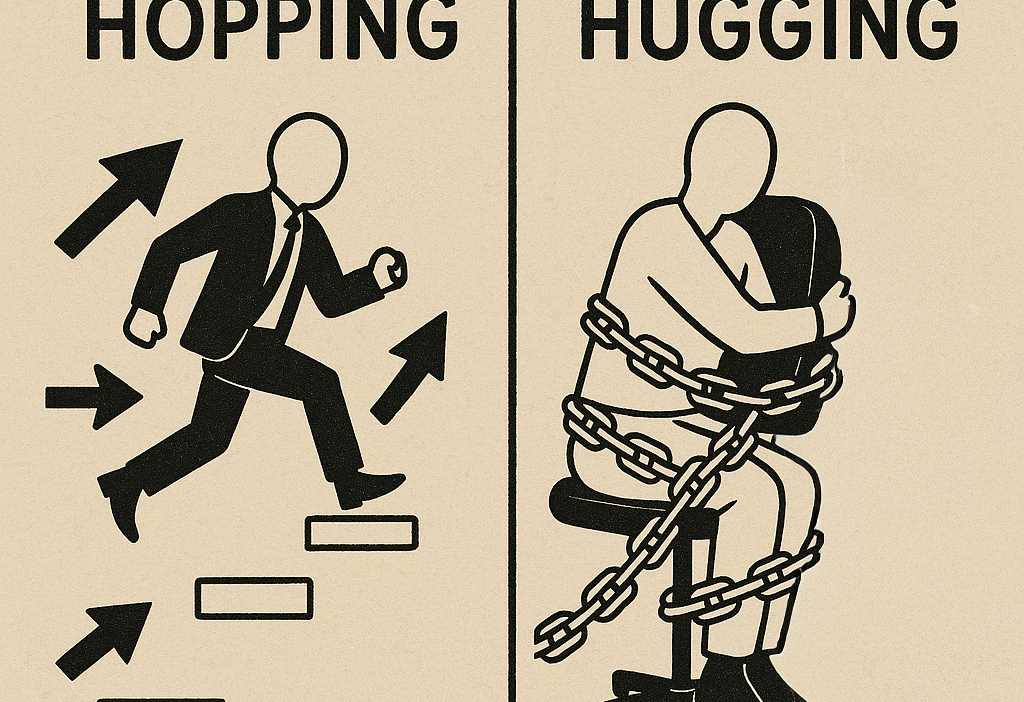When the job market cools, clinging feels safe—until you realize it’s quietly taxing your pay, options, and innovation.
Your calendar is full. Your Slack is green. Your performance review says “solid.” You tell yourself you’re choosing stability. But your skills aren’t compounding, your network is shrinking, and every quarter your promotion becomes “let’s revisit next cycle.” That isn’t stability. That’s job hugging—clinging to the chair because the outside looks risky.
Job hugging feels safe but silently taxes your career and your company. It steals pay compounding, shrinks opportunity surface area, and stalls innovation—all while looking like loyalty.
This guide explains what job-hugging is, why it surges in cool markets, and how to beat it without quitting.

What changed: from hop to hug
The 2021–2022 era rewarded movers—multiple offers, instant title bumps. That regime is gone. August 2025: job openings ~7.2M, hires rate 3.2%, quits 1.9%, layoffs 1.1%—a classic “low hiring, low firing, low churn” equilibrium. Translation: fewer easy outside wins, fewer pink slips, more people hugging the job they have. (Indeed Hiring Lab Japan)
Mainstream coverage mapped the pivot. Business Insider popularized the phrase “job hugging… for dear life,” Fast Company ran explainers and survey cuts, and Forbes flagged tell-tale behaviors leaders should watch. The through line: caution—from workers and executives alike. (Business Insider)
This guide explains what job hugging is and why job hugging spikes when hiring cools.
The hidden invoice: four ways hugging bills you
1) The compounding tax
Big pay steps tend to come from market resets, not 3–5% merit increases. In a low-churn market, internal negotiations anchor to last year’s number; with hiring cooler and confidence softer, fewer workers test the market—so leverage fades. (Business Insider)
What to do: Tie asks to shipped business outcomes, not tenure, and keep a light external cadence (one screen a month). You’re not planning to jump; you’re maintaining a BATNA so internal conversations stay honest.
2) The BATNA tax (when you stop sampling the market)
Warm outside options are oxygen for good negotiations. Shut off interviews and your “best alternative” withers. Coverage highlights the loop: fewer interviews → lower confidence → even fewer interviews. That’s how careers stall quietly. (Fast Company)
3) The entropy tax on skills (static workflows ≠ growing value)
Companies only see real productivity gains from AI when workflows change—not when a chatbot appears on the homepage. If your day-to-day hasn’t evolved in a year, hugging accelerates skill decay. Lead small rewires that move KPIs. (Indeed Hiring Lab Japan)
4) The opportunity tax (surface area shrinks)
Cross-team rotations, conferences, quick recruiter calls—these create weak ties that surface unexpected opportunities. Hugging collapses that graph. Business Insider notes workers staying put “for dear life,” while leaders sometimes misread stillness as health. It isn’t. (Business Insider)
Myth-busting: was hopping just a Gen-Z thing?
No. The “young people don’t stay” narrative was overstated. Tenure patterns move with the business cycle. When the market ran hot, everyone hopped more; as it cooled, everyone hugged more. Treating movement as a moral trait is how leaders misprice talent and miss internal-mobility wins. (See quits 1.9% and neutral hiring pulse for August 2025.) (Bureau of Labor Statistics)
Four job-hugger archetypes (and how to spot them)
- The Anchor: superb at BAU; hasn’t shipped a new capability in 12 months.
- The Ghost: output looks fine; zero external signal; network atrophy evident.
- The Reluctant Star: high impact; waiting for calmer waters; comp plateaued.
- The Loyal Worrier: loves the team; fears the market; avoids scope bids.
If you recognize yourself or your team here, you’re in hug territory.
Leaders can turn job-hugging into momentum by redesigning how talent moves internally.
Why leaders should care: brittle stability
Low quits can look like a retention win and act like disengagement. Analysts describe 2025 as “low firing, low hiring, low churn.” Combine that with softer confidence and you get teams that pause ambition and default to incremental projects—idea velocity falls before revenue does. (Indeed Hiring Lab Japan)
The leadership playbook: design motion on purpose
You can’t change macro. You can change how talent moves inside your org.
1) Launch an Internal Opportunity Exchange (30 days)
A living board for rotations, sprints, backfills with skills, time boxes (4–12 weeks), % allocations (10–20%), and a named decision owner with a response SLA. Track apps per opening and transfer rate as OKRs. This short-circuits manager hoarding and gives ambitious people oxygen when the external market is cool. (Fast Company)
2) Run quarterly “career auctions”
Each quarter, teams post 5–10 scoped projects. Employees “bid” fractional time. A talent council allocates and publishes results in all-hands. It normalizes movement and makes ambition visible.If you’re scaling go-to-market alongside mobility, revisit our 4P Marketing Mix primer.
3) Fund skill-for-output stipends (not generic L&D)
Mini-grants ($300–$1,000) only when tied to a shipped improvement with a KPI delta (e.g., ↑ first-contact resolution, ↓ cycle time, ↑ win rate). Research drumbeat: AI ROI follows workflow redesign, not tool vanity. Pay for the redesign. (Indeed Hiring Lab Japan)
4) Incent managers to release talent
Micro-SPIFs or headcount credits for managers who release top performers to higher-impact internal roles. Celebrate transfers publicly. Reward mobility, not tenure.
5) Publish promotion SLAs and ladder transparency
Post time-in-level expectations and decision windows. Ambiguity breeds hugging; clarity breeds bids on internal roles.
Leaders can turn job-hugging into motion by redesigning how talent moves internally.
The operator playbook: compound in place (even if you stay)
This isn’t “quit.” This is ship.
1) Do a 90-day Value Sprint (one workflow, one KPI delta)
Pick one workflow you touch daily and re-wire it:
- Sales Ops: AI-assisted outreach/proposals; human-edit for Tier-A; instrument win-rate & cycle time.
- Customer Support: AI triage + macro refactors; instrument first-contact resolution & AHT.
- FP&A: AI-assisted variance narratives + anomaly flags; compress the month-end close.
Publish a before/after dashboard. Package prompts/SOPs as a reusable asset. That’s portable value—and it’s exactly where companies are actually getting returns this cycle. (Indeed Hiring Lab Japan)
2) Keep a one-screen-a-month cadence
You’re not job hunting; you’re market-calibrating. In a low-churn world, a warm BATNA keeps internal conversations grounded. (Bureau of Labor Statistics)
3) Expand your surface area (10% rotation)
Volunteer for a 10% rotation with RevOps, Product Ops, or Data. New collaborators → more advocates → more internal options.
4) Re-benchmark comp twice a year
Anchor requests to shipped outcomes (your Value Sprint) and to ranges you hear in screens. Evidence beats seniority.
5) Build a BATNA file
One living doc: quantified wins, stakeholder quotes, recruiters, and 2–3 artifacts (template, dashboard, deck). Confidence comes and goes; evidence travels.For role-by-role upskilling ideas, see AI-Proof Careers 2025.
Two quick case notes (composite, anonymized)
Case A — Turning low churn into high motion
A 130-person B2B SaaS org froze external hiring but launched an Internal Opportunity Exchange + quarterly auctions. In two quarters: internal transfer rate 3% → 8%, time-to-staff hard projects –29%, shipped experiments +21%. Voluntary quits stayed low—but now for the right reason (progress, not fear). The pivotal move? Micro-SPIFs for managers who released talent. (Indeed Hiring Lab Japan)
Case B — Compounding in place without hopping
A CX lead ran a 90-day Value Sprint: AI triage + macro refactors + QA handoffs. First-contact resolution +8 pts; AHT –13%; two juniors re-skilled into QA using the new SOPs. The IC brought the deck + metrics to comp review—and kept a one-screen-a-month routine. Outcome: scope bump, new title, 11% raise, warm outside option. (Indeed Hiring Lab Japan)
Global snapshot (it’s not just the U.S.)
The same “hold” posture is showing up abroad as openings cool from post-pandemic highs. For a U.S. pulse on August specifically, both AP and MarketWatch frame conditions as stagnant—openings ~7.2M, weaker hiring, fewer quits. (AP News)
In 2025, the real risk isn’t a bold move—it’s job-hugging that freezes pay, options, and innovation.
FAQs
Is job hugging ever rational?
Yes—if your scope, skills, and network are expanding. That’s not hugging; that’s building. The tell is motion.
Did staying start to pay more in 2025?
Some stayers saw modest wage firmness—but with quits at ~1.9% and hiring subdued, leverage still comes from evidence + external signal, not tenure alone. Ship a KPI delta and keep one screen a month. (Bureau of Labor Statistics)
Won’t AI make moving riskier?
Only if you stand still. Firms see returns when humans re-wire workflows. Lead that, and your value goes up, not down. (Indeed Hiring Lab Japan)
We have near-zero voluntary turnover. Isn’t that good?
Not automatically. “Low firing, low hiring, low churn” can mask stagnation. Measure internal transfer rate, apps per internal opening, shipped experiments—not just attrition. (Indeed Hiring Lab Japan)
Sources (recent, reputable)
Fast Company — “What is job hugging?” (Aug 18, 2025). (Fast Company)
BLS — JOLTS August 2025: quits 1.9% (3.1M). (Bureau of Labor Statistics)
BLS — Full PDF (Aug 2025 JOLTS): details on openings, hires, quits, layoffs. (Bureau of Labor Statistics)
Indeed Hiring Lab — “August 2025 JOLTS: Low Firing, Low Hiring, Low Churn” (Sep 30, 2025). (Indeed Hiring Lab Japan)
AP News — “US job openings barely budged in August at 7.2 million” (Sep 30, 2025). (AP News)
MarketWatch — “It’s a tough jobs market… businesses hire at the slowest pace since the pandemic, and fewer people are quitting” (Sep 30, 2025). (MarketWatch)
Business Insider — “Workers are ‘job hugging’ for dear life” (Aug 2025). (Business Insider)
Table of Contents






